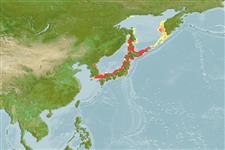>
Salmoniformes (Salmons) >
Salmonidae (Salmonids) > Salmoninae
Etymology: Oncorhynchus: Greek, onyx, -ychos = nail + Greek, rhyngchos = snout (Ref. 45335).
Environment: milieu / climate zone / depth range / distribution range
Ökologie
seewasser; süßwasser; brackwasser benthopelagisch; anadrom (Ref. 51243); tiefenbereich 0 - 200 m (Ref. 50550). Temperate; 65°N - 34°N, 127°E - 158°E
Northwest Pacific: Japan and adjacent waters.
Size / Gewicht / Alter
Maturity: Lm ? range ? - ? cm
Max length : 79.0 cm TL Männchen/unbestimmt; (Ref. 56527); max. veröff. Gewicht: 10.0 kg (Ref. 9988)
The fluviatile form generally inhabits headwaters and often maintains a territory; it feeds mainly on insects but also on small crustaceans and fishes. The sea-run form goes downstream forming schools, and after a short stay in the brackish zone enters the sea where it feeds on small fishes and pelagic crustaceans. Oviparous (Ref. 205). Eggs are buried in unguarded nests (Ref. 205). Marketed fresh and frozen; eaten broiled and baked (Ref. 9988).
Distinct pairing (Ref. 205). Reproductive strategy: synchronous ovarian organization, determinate fecundity (Ref. 51846).
Masuda, H., K. Amaoka, C. Araga, T. Uyeno and T. Yoshino, 1984. The fishes of the Japanese Archipelago. Vol. 1. Tokai University Press, Tokyo, Japan. 437 p. (text). (Ref. 559)
IUCN Rote Liste Status (Ref. 130435)
Bedrohung für Menschen
Harmless
Nutzung durch Menschen
Fischereien: kommerziell; Aquakultur: kommerziell; Sportfisch: ja
Tools
Zusatzinformationen
Download XML
Internet Quellen
Estimates based on models
Preferred temperature (Ref.
123201): 0.3 - 16.5, mean 3.3 °C (based on 86 cells).
Phylogenetic diversity index (Ref.
82804): PD
50 = 0.5000 [Uniqueness, from 0.5 = low to 2.0 = high].
Bayesian length-weight: a=0.00955 (0.00605 - 0.01506), b=3.03 (2.90 - 3.16), in cm total length, based on LWR estimates for this species & Genus-body shape (Ref.
93245).
Trophic level (Ref.
69278): 3.6 ±0.59 se; based on food items.
Widerstandsfähigkeit (Ref.
120179): mittel, Verdopplung der Population dauert 1,4 - 4,4 Jahre. (tm=4; tmax=6; Fec=1,000).
Fishing Vulnerability (Ref.
59153): Moderate to high vulnerability (52 of 100).
Climate Vulnerability (Ref.
125649): Moderate to high vulnerability (49 of 100).
Nutrients (Ref.
124155): Calcium = 14.3 [4.9, 37.9] mg/100g; Iron = 0.265 [0.131, 0.597] mg/100g; Protein = 18.2 [17.0, 19.3] %; Omega3 = 1.64 [0.75, 3.60] g/100g; Selenium = 98.8 [29.8, 308.1] μg/100g; VitaminA = 14.2 [4.6, 42.8] μg/100g; Zinc = 0.545 [0.335, 1.074] mg/100g (wet weight);
